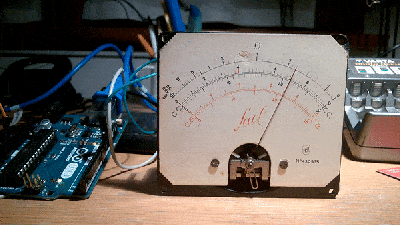We’ve seen many clocks here over the years. Some of them are conventional, some esoteric. So it’s not often that we see something novel in the world of timekeeping.
 Strictly speaking, [Giulio Pons]’s clock project isn’t new at all. He’s taken a broken multimeter from the 1950s, and with the help of an Arduino Nano and an ESP8266 module, converted it into a clock that indicates the time on the multimeter’s moving-coil meter. He’s wired the multimeter’s front panel controls to the Arduino to operate the thing, and given it a speaker to play alarm sounds. A PIR motion detector activates the clock. In the hours of darkness, a photoresistor brings up a light. Time setting is automatic via the internet. [Giulio] previously experimented with an RTC module but found the network connection made changing time settings easier.
Strictly speaking, [Giulio Pons]’s clock project isn’t new at all. He’s taken a broken multimeter from the 1950s, and with the help of an Arduino Nano and an ESP8266 module, converted it into a clock that indicates the time on the multimeter’s moving-coil meter. He’s wired the multimeter’s front panel controls to the Arduino to operate the thing, and given it a speaker to play alarm sounds. A PIR motion detector activates the clock. In the hours of darkness, a photoresistor brings up a light. Time setting is automatic via the internet. [Giulio] previously experimented with an RTC module but found the network connection made changing time settings easier.
It’s by no means the perfect timepiece. For instance, [Giulio] found that driving the meter from a PWM pin gave different readings depending on the PSU load from other parts such as the light. But the clock does work, and has breathed new life into what might otherwise have remained a piece of junk.
Those of you with long memories might remember a similar project from a few years ago that used unmodified multimeters to display time as voltage. And of course, there are always frequency counter clocks.
















The issue of the accuracy dependent on other loads in the circuit is testament to the sensitivity of the moving coil meter.
Place a resistor in parallel with thee meter will reduce the sensitivity somewhat
Use a resistor into a zener, and use that voltage to give a consistent ‘hi’ signal voltage from the PWM pin of the micro. That way the load on the power supply will have minimal effect on the meter reading.
So instead of repairing artifacts from the past we just rip them apart to make cool “new” clocks which dont even work properly? What a time to be a hobbyist…
Recently, someone ruined a perfectly fine 8086(!) Toshiba laptop just to connect its keyboard to their stupid ‘duino. Definitely sad times.
There: http://hackaday.com/2017/02/13/vintage-laptop-keyboard-types-again-through-usb/
It’s a cool hack, and the world has not run out of multi meters yet. I have preserved/repaired a few cool old ones, but if I had one with something fatal like a shot range switch I’d definitely hack into it for something like this.
Re the output voltage, one could sample the voltage with one A/D pin and regulate the value that way.